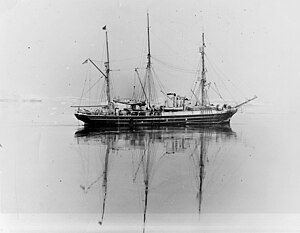Bear (ship)

USS Bear (AG-29) in Antarctica, 1939
|
|
| History | |
|---|---|
|
|
|
| Name: | SS Bear |
| Owner: |
|
| Port of registry: | St. John's, Newfoundland |
| Builder: | Alexander Stephen & Sons Ltd. Greenock, Scotland |
| Launched: | 1874 |
| Identification: | Official No. 66,840 |
| Fate: | Sold to U.S. government in 1884 |
|
|
|
| Name: | USRC Bear, USCGC Bear, USS Bear, Bear of Oakland (1926), Arctic Bear (1948) |
| Decommissioned: | 1948 |
| In service: | 1884–1929, 1939–1944 |
| Out of service: | 1926–1938 (museum ship); 1944–1948 (laid up) |
| Fate: | Sold to Canadian owners for sealing in 1948 |
| Notes: | Wireless call sign for USRC Bear was RCB. |
|
|
|
| Name: | SS Arctic Bear |
| Owner: | Shaw Steamship Line |
| Port of registry: | Halifax, Nova Scotia |
| Out of service: | 1948–1961 (protracted refits); 1962 (restaurant conversion) |
| Fate: | Sank in the Atlantic, 19 March 1963, while being towed |
| General characteristics | |
| Class and type: | ice strengthened aux. steamer 1 funnel, 3 masts |
| Displacement: | 703 tons |
| Length: | 198.5 ft (60.5 m) |
| Beam: | 30 ft (9.1 m) |
| Draft: | 18.8 ft (5.7 m) |
| Propulsion: | 300 ihp compound steam engine, 1 screw |
| Range: | Limited by water and provisions |
| Complement: | 51 |
| Aircraft carried: | Carried Barkley-Grow seaplane on Byrd Expedition III |
The SS Bear was a dual steam-powered and sailing ship built with six inch (15.2 cm) thick sides which had a long life in various cold-water and ice-filled environs. She was a forerunner of modern icebreakers and had an exceptionally diverse service life. According to the United States Coast Guard official website, Bear is described as "probably the most famous ship in the history of the Coast Guard."
Built in Scotland in 1874 as a steamer for sealing, she was owned and operated out of Newfoundland for ten years. In the mid-1880s, she took part in the search for the Greely Expedition. Captained by Michael Healy of the United States Revenue Cutter Service (later part of the U.S. Coast Guard), she worked the 20,000 mile coastline of Alaska. She later assisted with relief efforts after the 1906 San Francisco earthquake.
Her services also included the second expedition of Admiral Richard E. Byrd to Antarctica, and again to the southernmost continent in 1941 to evacuate Americans at the beginning of World War II. She later served in patrol duty off the coast of Greenland for the United States Navy. Between some of these missions, she was a museum ship in Oakland, California and starred in the 1930 film version of Jack London's The Sea-Wolf.
After World War II, Bear was returned to use again as a sealing vessel. Finally, in 1963, 89 years after she had been built, while being towed to a stationary assignment as a floating restaurant in Philadelphia, Bear foundered and sank in the North Atlantic Ocean about 100 miles (160 km) east of Cape Sable Island, Nova Scotia.
...
Wikipedia
